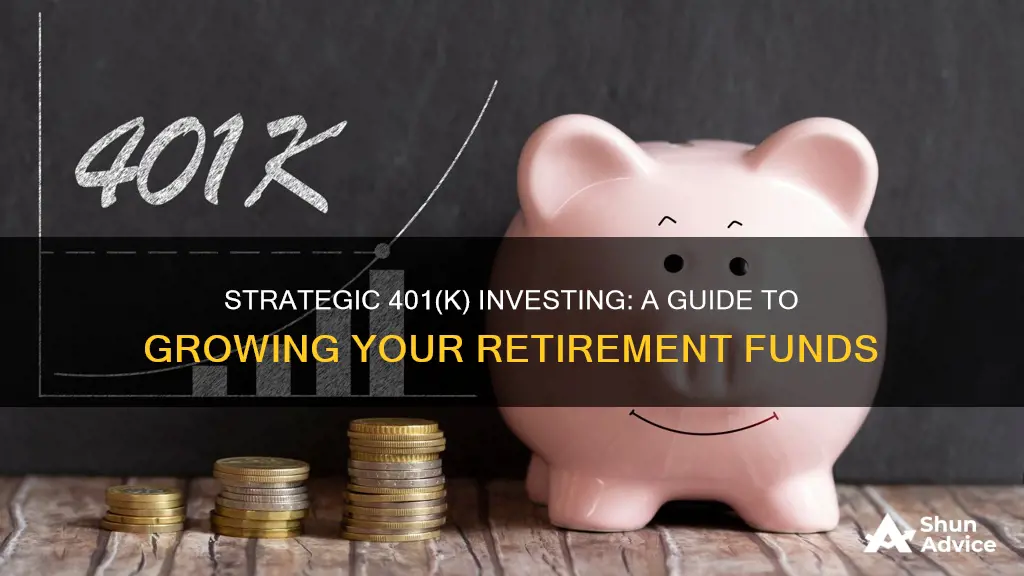
A 401(k) is a tax-advantaged retirement account offered by many employers. There are two types: traditional and Roth. When deciding how to invest your 401(k) funds, it's important to consider your financial goals, risk tolerance, time horizon, and the specific investment options available to you.
- Diversification: Diversifying your investments across different asset classes, such as stocks, bonds, and short-term investments, can help minimize risk and potentially increase your long-term returns.
- Long-term returns: Look at the fund's performance over five and ten-year periods, as well as since its inception.
- Expense ratio: This is the cost of holding the fund for a year, expressed as a percentage of the invested money. Lower expense ratios are generally preferable, as they can significantly impact your long-term returns.
- Risk tolerance: Consider your risk tolerance and adjust your investments accordingly. Younger investors may be more comfortable with a higher allocation to stocks, while older investors may prefer a more conservative approach.
- Time horizon: If you have a longer time horizon until retirement, you may be able to take on more risk and invest a larger percentage of your portfolio in stocks. As you get closer to retirement, consider shifting to more conservative options, such as dividend stock funds or bond funds.
- Employer match: Take advantage of any employer matching contributions to maximize your savings.
- Investment options: The most common investment options in 401(k) plans include stock mutual funds, bond mutual funds, target-date mutual funds, and stable value funds. Choose the options that align with your financial goals and risk tolerance.
| Characteristics | Values |
|---|---|
| Investment options | Target date funds, target allocation funds, managed accounts, self-managed accounts |
| Considerations | Long-term returns, expense ratio, risk tolerance, time horizon, diversification |
| Types of funds | Stock mutual funds, bond mutual funds, target-date funds, stable value funds, individual stocks, bonds, ETFs, mutual funds |
What You'll Learn

Choosing a target-date fund
Target-date funds are a popular choice for investors saving for retirement. These funds are designed to help manage investment risk and are based on your anticipated retirement date. You pick a fund with a target year closest to the year you plan to retire, and the fund will rebalance its investments as you approach that date.
- Pick your target date carefully: Choose a fund with a target date that aligns with your anticipated retirement year. For example, if you are 30 years old and plan to retire at 65, consider selecting a target-date fund with a date 35 years in the future.
- Assess your risk tolerance: Compare funds with similar target dates and examine their investment strategies. Select the fund that best matches your tolerance for risk. Remember that circumstances can change, so periodically monitor the fund's performance to ensure it remains aligned with your investment goals.
- Determine the fund's approach to retirement: Target-date funds can be designed to take you "to" or "through" retirement. A "to retirement" fund will reach its most conservative asset allocation on the target date, while a "through retirement" fund will continue to rebalance and gradually shift towards more conservative investments even after the target date.
- Monitor the glide path: The glide path refers to how the fund adjusts its mix of investments over time. Review the investments in your target-date fund periodically to ensure that the investment manager has not changed the glide path in a way that deviates from your retirement investment strategy or risk tolerance.
- Consider fees and expenses: As with any investment, fees are an important consideration. Compare the expense ratios of different target-date funds, as higher fees can erode your returns over time.
- Understand the fund's investing philosophy: Even funds with the same target date can have different investment strategies. Evaluate the fund's approach to dialing down from a heavier mix of equities towards more conservative investments, such as bonds, as you age. Ensure that the fund's strategy aligns with your risk tolerance and investment goals.
Remember, target-date funds are just one option for investing your 401(k) funds. It's important to consider your personal circumstances, risk tolerance, and investment goals when making investment decisions.
Mutual Funds: A Smart Investment Strategy?
You may want to see also

Understanding the risks
Investing in a 401(k) plan is not without its risks. Here are some key considerations to help you understand the potential risks involved:
- Market Risk: Your 401(k) portfolio will likely be exposed to market risk, especially if it includes stocks, bonds, or other volatile assets. A downturn in the market, especially just before retirement, can significantly impact your retirement funds. While diversification can help mitigate this risk, it's important to remember that even a diversified portfolio is subject to market fluctuations.
- Limited Investment Options: 401(k) plans typically offer a limited range of investment options, which may not cover all the asset classes you need to build a comprehensive portfolio. This limitation can impact your ability to diversify and may require you to invest in riskier options to achieve your desired returns.
- High Fees: Some 401(k) plans charge high administrative and record-keeping fees, eating into your investment returns. Actively managed funds, in particular, tend to have higher management fees due to the cost of research and oversight. It's important to carefully evaluate the fees associated with your 401(k) plan and consider alternative options if the fees are excessive.
- Tax Implications: The tax advantages of 401(k) plans can be complex and may not always work in your favor. While contributions are often made on a pre-tax basis, reducing your taxable income, withdrawals in retirement are taxed as income. This means that if your investments achieve substantial long-term gains, you may end up paying a higher tax rate than if you had invested through a different vehicle.
- Lack of Liquidity: Funds in a 401(k) plan are typically not easily accessible. Early withdrawals may incur penalties, and you may not be able to access your money when needed. It's important to have a separate emergency fund or savings account to cover unexpected expenses before retirement.
- Investment Time Horizons: 401(k) plans are typically designed for long-term savings, and early withdrawals can be costly. It's important to consider your investment time horizon and ensure that your 401(k) investments align with your short-term and long-term financial goals.
- Record-keeping Challenges: Record-keeping for 401(k) plans can be complex, and you may not receive comprehensive, user-friendly statements. It may be necessary to manually compile and analyze your investment information to make informed financial decisions.
- Employer Matching Contributions: While employer matching contributions can boost your retirement savings, they may come with vesting restrictions. These restrictions can impact your ability to access the full value of your 401(k) if you leave or change jobs.
It's important to carefully consider these risks and weigh them against the benefits of investing in a 401(k) plan. Diversification, regular monitoring, and seeking professional financial advice can help you mitigate some of these risks and maximize the potential benefits of your 401(k) investments.
Retirement Fund Investment: Choosing the Right Option
You may want to see also

Diversifying your portfolio
Understanding Diversification
Diversification is a risk management strategy that involves spreading your investments across various assets, sectors, and geographies. By allocating your 401(k) funds across different types of investments, you can reduce the impact of losses in any single investment and potentially enhance your overall returns. Diversification helps you capture a mix of investment returns while protecting your portfolio from the risks associated with any one asset class.
Benefits of Diversification
Diversification offers several advantages:
- Risk Management: Diversification helps manage risk by reducing exposure to any single investment or asset class. If one investment performs poorly, other investments may offset those losses.
- Improved Returns: While diversification does not guarantee higher returns, it can improve overall performance by allowing you to capture gains from different investments.
- Long-Term Value: Historical data shows that diversification helps contain portfolio losses during market downturns and captures market gains during recoveries.
- Customized Risk Level: Diversification allows you to choose an investment strategy that aligns with your risk tolerance. You can adjust your asset allocation based on your comfort with risk and your financial goals.
Implementing Diversification
- Target-Date Funds: If you prefer a hands-off approach, consider target-date funds. These funds automatically adjust their allocation over time, becoming more conservative as your retirement date approaches. They are a good option for investors who want a simple, set-it-and-forget-it solution.
- Mix of Funds: If you want more control over your asset allocation, consider choosing a mix of stock and bond mutual funds, including domestic and international options. As you get older, gradually increase your bond allocation and reduce stocks, as bonds are generally less volatile.
- Asset Allocation: Determine an appropriate mix of stocks, bonds, and other investments based on your risk tolerance and financial goals. A common guideline is to subtract your age from 110 or 120 to get the target allocation of stocks. For example, if you're 30 years old, you might aim for 80%-90% stocks and 10%-20% bonds.
- Avoid Overconcentration: Be cautious of overconcentrating your investments in a single company stock, including your employer's stock. A general rule of thumb is to limit any single stock to no more than 10% of your portfolio to minimize risk.
- Regular Check-Ins: Diversification is not a one-time task. Regularly review your portfolio, at least annually or when your financial circumstances change. This allows you to make adjustments and rebalance your portfolio to maintain your desired risk level.
Final Thoughts
Diversification is a powerful tool for managing your 401(k) investments. It helps protect your portfolio from significant losses, captures returns from different investments, and allows you to customize your risk exposure. By diversifying your 401(k) portfolio, you can improve your investment experience and work towards your financial goals with greater confidence.
Diversify Your Portfolio: Avoid Single Mutual Fund Investments
You may want to see also

Considering your financial goals
When considering your financial goals, it's important to remember that your 401(k) investments should be based on your unique circumstances, such as your time horizon and risk profile. Here are some key things to keep in mind:
- Determine your risk tolerance: All investing carries risk, and returns are never guaranteed. However, holding too much cash can also be risky due to inflation. You need to decide on an appropriate asset allocation, balancing stocks (equities) with "safer" investments like bonds. Stocks offer the potential for greater returns but are more volatile, while bonds are more stable and generate reliable income.
- Consider your investment horizon: If you have many years until retirement or your planned distribution date, you can afford to take on more risk to aim for higher returns. Younger investors, for instance, may want a higher allocation of stocks in their portfolio compared to older investors.
- Calculate how much you can contribute: Financial experts recommend contributing as much as you can afford, ideally between 10% to 15% of your income, especially when you're young. Take advantage of any company match on contributions, as this is essentially free money that your employer owes you as part of your compensation.
- Diversify your portfolio: Diversification helps to minimize risk and may even increase your long-term returns. Avoid putting all your money into one type of asset or fund. Spread your investments across different sectors, such as large, medium, and small-cap stocks, as well as bonds.
- Evaluate your financial goals: Your investment portfolio should reflect your financial goals. For example, if you're aiming for higher returns, you'll likely need to invest more in stock funds.
- Monitor and rebalance your portfolio: Once you've set your investment allocation, leave it alone for the most part, but do review it annually. If you're managing your own portfolio, make sure to rebalance it regularly to ensure it aligns with your desired allocation.
- Be mindful of fees: Fund expenses eat into your returns, so pay attention to the fees associated with the funds you invest in. Opt for lower-cost options, such as index funds, whenever possible. Even small differences in fees can have a significant impact on your returns over time.
Rental Property vs Mutual Funds: Which is the Better Investment?
You may want to see also

Evaluating your risk tolerance
When it comes to investing in a 401(k), it's important to evaluate your risk tolerance, or how much fluctuation you're comfortable with in your savings. Here are some things to consider when assessing your risk tolerance:
Understanding Risk Tolerance
Risk tolerance refers to how comfortable you are with potential losses in your investment portfolio. It's an individual assessment of your willingness to take on risk in pursuit of potential gains. The more risk you're willing to take, the greater the potential gains or losses. It's important to be honest with yourself when determining your risk tolerance.
Factors to Consider
When evaluating your risk tolerance, consider your financial circumstances, goals, and time horizon. Ask yourself the following:
- How much income growth do you anticipate in the coming years? If your compensation is expected to increase significantly, you may want to raise your risk threshold.
- What are your thoughts on the stock market? While stocks historically outperform other investments over time, there are also lower-risk options, such as mutual or exchange-traded funds that invest in bonds, precious metals, or stable companies.
- What type of lifestyle do you want? If you desire a lavish lifestyle with a large family, expensive cars, and a big house, you'll need to balance those goals with more cautious investments.
- When do you plan to retire, and what does your ideal retirement look like? Do you want to retire early? Do you plan to downsize or maintain your current lifestyle? Do you dream of travelling? Do you anticipate needing additional funds for healthcare? These questions will help shape your investment strategy and determine how much money you need to save.
Risk Tolerance and Investment Choices
Your risk tolerance will influence the types of investments you choose for your 401(k). If you have a high-risk tolerance, you may be comfortable with aggressive investment options, such as high-risk stocks, in hopes of higher returns. On the other hand, if you have a low-risk tolerance, you may prefer a more conservative approach with lower-risk investments like bonds, money market funds, or target-date funds. Remember that lower risk usually means lower returns.
Adjusting Risk Tolerance Over Time
It's important to note that your risk tolerance may change over time. As you get closer to retirement, you may opt for less risky investments to maintain stability. Additionally, your risk tolerance may evolve as your financial circumstances, goals, or market conditions change.
Seeking Professional Advice
Evaluating risk tolerance can be complex, and it's normal to feel unsure about your level of comfort with risk. Consider working with a financial professional who can help you shape your risk philosophy and suggest investment products that align with your tolerance.
Remember, investing in a 401(k) is a long-term strategy, and it's important to make informed decisions based on your risk tolerance, goals, and time horizon.
Global Funds: Where Are They Invested?
You may want to see also
Frequently asked questions
Contact your company's HR or payroll department to set up a brokerage account with the firm managing your company's 401(k) funds. During the setup, you can choose how much to invest and where to allocate your funds.
The Vanguard 500 Index (FXAIX) is a popular mutual fund with an expense ratio of only 0.015%. The Vanguard Mid-Cap Index Institutional (VMCIX) is another option with a low expense ratio that focuses on mid-cap stocks. If you're looking for small-cap stocks, consider the Vanguard S&P Small-Cap 600 Index (VSMSX).
Young adults with a long time horizon until retirement should focus on more aggressive 401(k) investments, such as stock funds, as they can provide superior long-term growth.
This depends on your individual needs and preferences. If you're nearing retirement, you may want to shift to more conservative options, such as dividend stock funds or bond funds, to protect your accumulated earnings. If you're just starting your career, you may prefer more aggressive stock funds with higher growth potential.
Contribute at least enough to get the full benefit of your employer's match, if they offer one. In general, saving at least 15% of your pre-tax income for retirement, including any employer match, is recommended.







